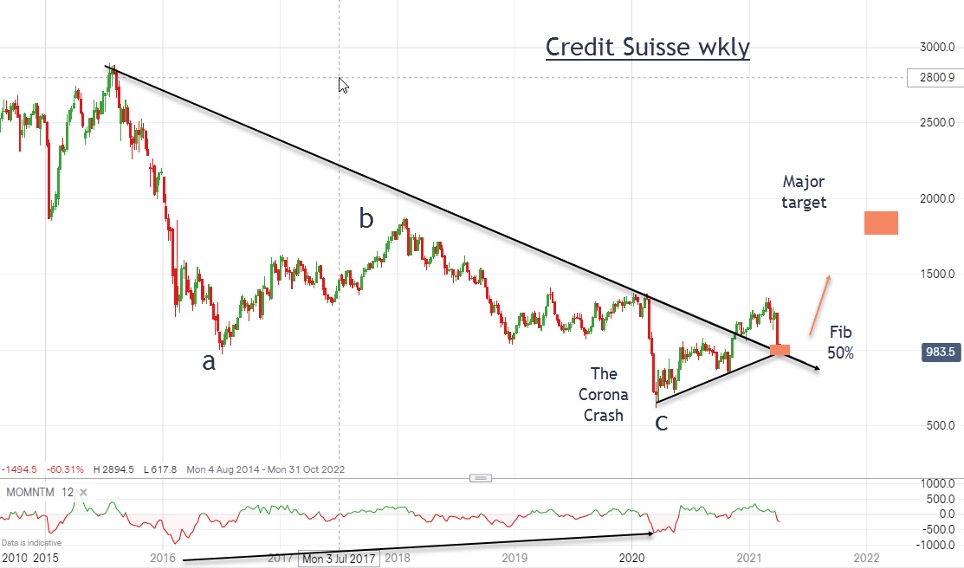Chart of the week: is there an opportunity in the Credit Suisse fallout?
The latest markdown could be a great buying opportunity - or buyers may be catching a falling knife.
12th April 2021 17:15
by John Burford from interactive investor
The latest markdown could be a great buying opportunity - or buyers may be catching a falling knife.

Major Swiss bank Credit Suisse (SIX:CSGN) is being caught up in the recent well-publicised Archegos hedge fund affair, which imploded spectacularly to land the bank with multi-billion dollar losses (and counting).
The continuing fall-out from this sad tale is the departure of several top risk management officials – and a severe markdown in the share price by a quarter.
There may well be other highly leveraged hedge funds lurking out there that could expose major banks to additional huge losses.
Whenever there is a bank crisis, it is typically when they become over-leveraged, such as in the US Savings and Loan Crisis from 1985–1995, which decimated bank shares at the time.
- A stock you can buy low and sell high
- Chart of the week: I expect this bank share to double in value
- Are you saving enough for retirement? Our calculator can help you find out
I like to think that bankers aren't stupid, but some of them have their moments. A common flaw is having an infinite variety of creative ways to lose money at certain times.
So does this markdown present a great buying opportunity, or will buyers be catching a falling knife?

Source: interactive investor. Past performance is not a guide to future performance.
This is the long-term chart and shows the all-time high at the March 2020 coronavirus crash low at the 6 CHF mark.
Since then it has taken part in the general stock market rally to reach the February high at 13.50 CHF.
Note the large momentum divergence at the all-time low and the break above the major trend-line off the August 2015 high. Both are potentially bullish signs.
With the Archegos revelations, the shares have sunk back to kiss this trend-line and make a Fibonacci 50% retrace of the rally off the 'c' wave low. Both events are potentially major support areas that should lead to a resumption of the uptrend.
But note the form of the rally off the 'c' wave low – it is in a three and that is potentially bearish as threes are corrective to the main trend. But on balance, with other bank shares in uptrends (see my latest bullish coverage of Lloyds and Barclays), we should have a tailwind behind Credit Suisse for support.
If the rally can be maintained, I have a major target in the 18 CHF region with higher potential (latest trade 9.80 CHF). Only a decline below 8 CHF would send me back to the drawing board. I am adding it to my ‘buy low, sell high’ list.
John Burford is the author of the definitive text on his trading method, Tramline Trading. He is also a freelance contributor and not a direct employee of interactive investor.
These articles are provided for information purposes only. Occasionally, an opinion about whether to buy or sell a specific investment may be provided by third parties. The content is not intended to be a personal recommendation to buy or sell any financial instrument or product, or to adopt any investment strategy as it is not provided based on an assessment of your investing knowledge and experience, your financial situation or your investment objectives. The value of your investments, and the income derived from them, may go down as well as up. You may not get back all the money that you invest. The investments referred to in this article may not be suitable for all investors, and if in doubt, an investor should seek advice from a qualified investment adviser.
Full performance can be found on the company or index summary page on the interactive investor website. Simply click on the company's or index name highlighted in the article.
Disclosure
We use a combination of fundamental and technical analysis in forming our view as to the valuation and prospects of an investment. Where relevant we have set out those particular matters we think are important in the above article, but further detail can be found here.
Please note that our article on this investment should not be considered to be a regular publication.
Details of all recommendations issued by ii during the previous 12-month period can be found here.
ii adheres to a strict code of conduct. Contributors may hold shares or have other interests in companies included in these portfolios, which could create a conflict of interests. Contributors intending to write about any financial instruments in which they have an interest are required to disclose such interest to ii and in the article itself. ii will at all times consider whether such interest impairs the objectivity of the recommendation.
In addition, individuals involved in the production of investment articles are subject to a personal account dealing restriction, which prevents them from placing a transaction in the specified instrument(s) for a period before and for five working days after such publication. This is to avoid personal interests conflicting with the interests of the recipients of those investment articles.